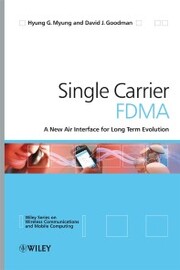Detailansicht
Single Carrier FDMA
eBook - A New Air Interface for Long Term Evolution, Wireless Communications and Mobile Computing
ISBN/EAN: 9780470758700
Umbreit-Nr.: 3681157
Sprache:
Englisch
Umfang: 198 S., 4.68 MB
Format in cm:
Einband:
Keine Angabe
Erschienen am 20.11.2008
Auflage: 1/2008
E-Book
Format: PDF
DRM: Adobe DRM
- Zusatztext
- Single Carrier Frequency Division Multiple Access (SC-FDMA) is a novel method of radio transmission under consideration for deployment in future cellular systems; specifically, in 3rd Generation Partnership Project Long Term Evolution (3GPP LTE) systems. SC-FDMA has drawn great attention from the communications industry as an attractive alternative to Orthogonal Frequency Division Multiple Access (OFDMA).<p><i>Introduction to Single Carrier FDMA</i> places SC-FDMA in the wider context of wireless communications, providing the reader with an in-depth tutorial on SC-FDMA technology. The book introduces the reader to this new multiple access technique that utilizes single carrier modulation along with orthogonal frequency multiplexing and frequency domain equalization, plus its applications in communications settings. It considers the similarities with and differences from orthogonal frequency division modulation, multiplexing, and multiple access used extensively in cellular, broadcasting, and digital subscriber loop applications. Particular reference is made to the peak power characteristics of an SC-FDMA signal as an added advantage over OFDMA.</p><ul><li><p>Provides an extensive overview of the principles of SC-FDMA and its relation to other transmission techniques.</p></li><li><p>Explains how the details of a specific implementation influence the tradeoffs among various figures of merit.</p></li><li><p>Describes in detail the configuration of the SC-FDMA uplink transmission scheme published by 3GPP.</p></li><li><p>Features link level simulation of an uplink SC-FDMA system using MATLAB.</p></li></ul><p>This is an essential text for industry engineers who are researching and developing 3GPP LTE systems. It is suitable for engineers designing wireless network equipment, handsets, data cards, modules, chipsets, and test equipment as well as those involved in designing LTE infrastructure. It would also be of interest to academics, graduate students, and industry researchers involved in advanced wireless communications, as well as business analysts who follow the cellular market.</p>
- Autorenportrait
- <p><b>Hyung G. Myung</b> currently works as a senior engineer at Qualcomm/Flarion Technologies, Bedminster, New Jersey. His research interests include 3GPP Long Term Evolution and Single Carrier FDMA. Myung served in the Republic of Korea Air Force between 1996 and 1999 and then worked as a software engineer for ArrayComm, California between 2001 and 2002. During the summer of 2005 he worked at the Communication& Networking Lab at the Samsung Advanced Institute of Technology, and he then worked at the Air Interface Group of InterDigital Communications Corporation, New York as an intern between February and August 2006.</p><p><b>David Goodman</b> has been a Professor of Electrical and Computer Engineering at Polytechnic University in Brooklyn, New York, since 1999. He currently holds a temporary position as Program Director in the Computer and Network Systems Division of the National Science Foundation.</p>
